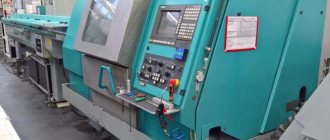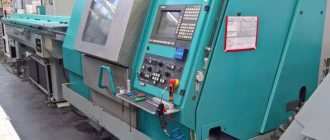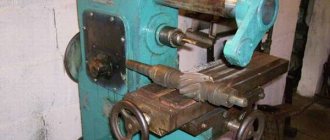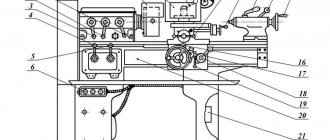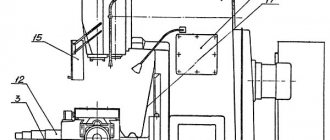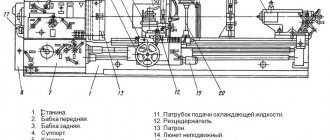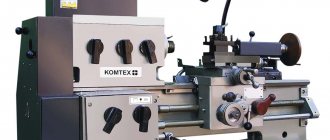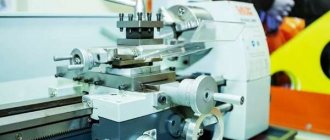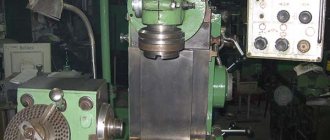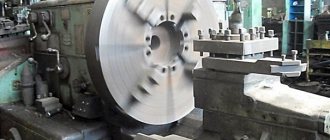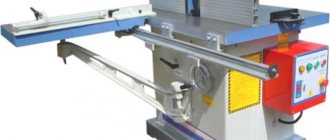A numerically controlled turning center is perhaps the most popular and, accordingly, widespread type of equipment in most machining industries.
Modern turning equipment allows you to automatically perform various operations, working according to a control program: rough turning, fine turning, including complex shaped surfaces, thread cutting, drilling and boring. To perform various operations on the machine, as they say “in one setup,” lathes are equipped with multi-position turrets, which allow multi-tool setup on the machine to produce complex parts.
According to the layout, lathes can be horizontal, i.e. with a horizontal axis of the turning spindle or in a vertical version.
To increase versatility and expand technical functions, lathes can be additionally equipped with a driven milling tool, which allows, along with a variety of turning operations, to perform certain milling and drilling operations on one machine, eliminating interoperational time losses, increasing accuracy and productivity.
To solve specific production problems, turning centers can be equipped with a controlled tailstock for processing long parts such as a shaft or axle, a controlled counter-spindle for complex processing of a part on both sides “in one setup,” or several turrets to increase productivity.
CNC turning centers can be easily automated by connecting bar workpiece loaders or by connecting robotic manipulators for loading and unloading workpieces, depending on the production task.
Types of turning and milling centers
They are classified according to the following criteria:
- presence or absence of a CNC block;
- direction of spindle movement (it can be vertical or horizontal);
- list of permitted operations.
Units not equipped with CNC are produced:
- with manual control;
- semi-automatic;
- fully automatic.
The CNC turning and milling machining center has several varieties:
- the so-called classical layout;
- equipped with a special counter-spindle;
- having a built-in drive;
- milling machine with turning axis;
- established by the so-called C-axis.
CNC turning center
Turning center with counter spindle
Each of them is capable of simultaneously performing a large sequence of processing operations.
Technical parameters and advantages
The development of the design of branded turning machining centers takes into account modern advances in machine tool construction. Therefore, the new equipment uses improved parts and components, which significantly increase the productivity, reliability and reliability of the equipment. The design of the machines is optimized and designed for the production of the widest range of finished products, as well as for complex processing of parts with significant parameters. The modular principle of equipment production allows us to produce several different modifications of machines so that the customer can purchase equipment that fully meets all the requirements.
Depending on the design, today we offer customers machining centers with a set of turning tools, as well as individual machines and centers with disk turret heads with or without a drive. Working movements are provided by an engine with a belt drive and a gear motor.
Among the main advantages of using turning machining centers, it is worth highlighting the following properties:
- Reducing the number of production operations and related costs;
- High machining accuracy due to constant position of the part;
- Performing a full processing cycle on one machine;
- Reducing the cost of products;
- Minimizing the risk of defects and damage to the workpiece due to inaccurate or poor-quality processing, as well as due to accidental displacement of the center during numerous reinstallations;
- Possibility of manufacturing an unlimited number of parts with precisely specified parameters.
Main characteristics
The turning and milling center is a multifunctional device. It contains complex kinematics and electronic software. It is quite difficult to list all the characteristics of such units. They are included in the description of each machine. The main characteristics include the following:
- number of operations performed;
- processing accuracy class;
- permissible diameter and permitted length of the workpiece;
- type of installed CNC;
- maximum permissible movement of the caliper in the longitudinal and transverse plane;
- the power of each of the two drives (the drive of the main movement and the rotating tool);
- permissible limits of spindle speed (main, milling and drilling);
- high speed (in the X and Z planes mm/min, rotation C rpm);
- number of head positions;
- positioning accuracy in all planes;
- tool change time;
- geometric dimensions of the machine;
- full mass.
Approximate characteristics of a turning center
Applications and features of CNC technology
Universal metalworking centers are offered in several versions. The equipment combines the capabilities and advantages of milling and turning turret machines. The features of this technique are:
- high accuracy of turning operations, for example, grooving, threading, hole preparation;
- milling workpieces of any configuration, size, level of complexity, for example, development of grooves and grooves, preparation of profile surfaces;
- processing machines are made on the basis of a modular principle, high-precision equipment can be modernized and modified;
- Each unit includes a module; the presence of software control makes the machines functional and in demand on the market.
The main characteristics of the units are overall dimensions, spindle parameters, rotation speed, number of available operations, structural rigidity, drive type and other criteria.
Operations Performed
The CNC turning center is capable of performing the following operations: drilling, turning and milling. Drilling can be done on flat and curved surfaces. All turning operations are carried out on them:
- turning of various cylindrical parts (cones, shafts, spheres);
- turning of various depths of grooves;
- bore the internal surfaces of the cylinders (for bearings or oil seals);
- perform reaming and honing;
- cutting various threads.
The turning and milling machine performs milling operations:
- planes;
- various bodies of rotation;
- shaped and profile milling;
- processing of screw products;
- gear hobbing.
Lathe machining center in operation
Universal multifunctional turning centers are used in the automotive and agricultural engineering, aviation and space industries. With their help, parts of complex geometric shapes are manufactured with high precision. First, the part is processed on a turning center. Then milling is carried out on CNC machines. This allows you to obtain a high quality surface.
Advantages of the equipment
When purchasing a vertical milling or turret lathe, a company spends more money than when purchasing a combined metalworking center. The advantages of this technique include:
- the workpiece is installed and fixed once for the entire processing cycle, which will allow achieving high accuracy of the finished product;
- the tool is changed according to the established algorithm; the operator is required to monitor the operation of the equipment and timely change of workpieces;
- the risk of producing defective parts is minimized, while the cost of production becomes lower and the production speed increases;
- machining centers are equipped with powerful and durable drives that operate without failures throughout their entire service life;
- versatility of use, with the help of a processing center it is possible to produce products of any complexity, the type of material also varies widely;
- machines are used to produce products in large and small batches; setting up a given operating algorithm takes a minimum of time.
sells Korean-made CNC machines that have a reputation for productive, multifunctional equipment. The quality of the drive, axles, bearings, and other structural elements is not satisfactory. The units can be ordered with delivery throughout the Moscow region and other regions of Russia. The company provides warranty and post-warranty maintenance of equipment and sells centers at competitive prices. If necessary, each client can count on professional advice and assistance in selecting technically complex and expensive devices.
Our advantages
| High-quality CNC vertical milling machines. On the market since 2004. |
| Reasonable prices. The cost of equipment is calculated individually. |
| Special price lists for our regular customers. |
| Reasonable deadlines. We fulfill the terms of the contract. Delivery just on time. |
Request for proposal
Send message
Hwacheon CNC Vertical Milling Machining Centers
The catalog of Finval Group of Companies presents various models of milling machining centers from Hwacheon (South Korea). The milling equipment of this brand is known for its high quality, reliability and high precision. The CNC installed on the machines contributes to high productivity; the presence of microcommands on the machine screens allows the work to be performed more accurately and more comfortably for the operator.
Vesta series machines are improved with a chip removal system and an oil separation system, which help reduce equipment operating costs.
Hwacheon vertical milling machines are used for surface processing, contour chamfering, mold making, etc. Equipment of this type can process products made of titanium, aluminum, steel, and various alloys. The price depends on the type of machine and its configuration.
Turning and milling machining center: description, advantages
Turning and milling machining center is one of the most promising areas of modern machine tool industry, which in addition offers a huge selection of machines for various purposes. Currently, it is difficult to imagine a metal processing shop without computer numerical control (CNC) machines. This technology can increase production efficiency by an order of magnitude, since it is now possible to perform most of the technological operations on one machine. In this case, the workpiece does not move after it is installed. This means that the principle of maintaining databases is observed, which allows achieving the greatest processing accuracy. But such equipment also has its drawback in the form of high cost and places high demands on the qualifications of operating personnel.
Milling and turning machines of previous generations required the worker not only to know the design of the equipment, but also to directly participate in the process. In our time of dynamically developing industry, bulky “tools” of flow production are increasingly being replaced by automated lines based on the work of turning and milling machining centers .
Today, processing can occur without human intervention in the process due to the fact that modern machines have a multi-purpose purpose, are equipped with automatic tool changers, and the ability to autonomously install a workpiece, thereby reducing auxiliary time. In addition, software control allows you to automatically change cutting modes. But also, over time, not only the control capabilities of machine tools have changed, but also their design features. To manufacture parts, it is no longer necessary to create chains of individual “links” of technological processing; today an entire workshop can be replaced by one CNC machining center .
Multi-purpose machines differ from their predecessors by an impressive tool magazine, equipped with a variety of cutting surfaces, with which you can perform almost any technological operation.
In such conditions of development of machine tool industry, the capabilities of standard processing tools become insufficient. Therefore, a new niche is being formed for the creation of promising areas of research and design activity. Namely, the modernization of machine tools.
A modern turning-milling machining center is a multifunctional, universal machine that can perform complex milling operations and perform a full range of turning operations on workpieces made of various materials.
Equipment that allows for turning and milling processing is actively used today in both large and small industrial enterprises.
CNC turning and milling machining centers can be divided into three types:
- machines with drive center;
- machines with C-axis;
- units with counter spindle.
All of them combine the capabilities of lathes and milling equipment, but at the same time they have certain design and technological features.
On almost any standard turret lathe, it is possible to perform not only turning, but also drilling holes, as well as milling. Conventional turrets allow you to expand the functional range of the equipment, but the low mobility of this design greatly limits its production potential. Therefore, machines began to be equipped with heads with built-in rotating tools, which made it possible to carry out not only turning, but also full-fledged milling operations.
At the same time, the machines began to be equipped with an additional C-axis and automatic changers of working tools, which made it possible to process such complex parts as gears, as well as worm and crankshafts without reinstalling the workpiece.
Machines with a counter-spindle are even more functional in operation. It is placed instead of the tailstock. This device makes it possible to hold the product by the right side and at this moment, without the intervention of the unit operator, process its opposite side.
The counter-spindle, in essence, turns CNC turning and milling equipment into a multifunctional production line that is capable of performing processing work many times faster, without compromising the quality of the resulting products.
Let's take as an example a turning-milling processing center made in Taiwan (Fig. 1). The machine is distinguished, first of all, by a built-in full-fledged milling spindle located on an additional axis. Its power of 22 kW and rotation speed of 12,000 rpm allow the machine to process large parts with complex geometry, which require a large volume of milling processing along with turning. Also, the milling spindle allows for turning when installing various cutters into it.
This machining center , in addition to the milling one, is equipped with 2 spindles with direct drives of equal power 15/22 kW and a rotation speed of 4200 rpm, which ensures complete processing of both sides of the part, equal in technical capabilities.
